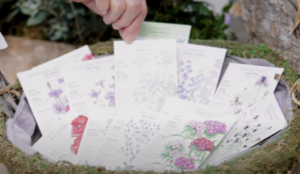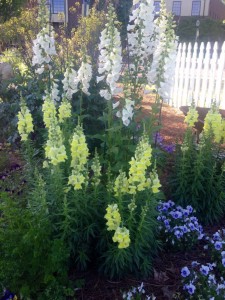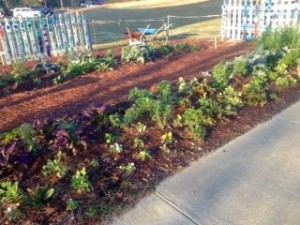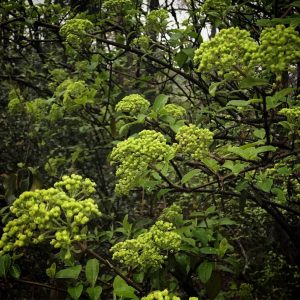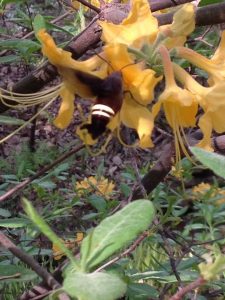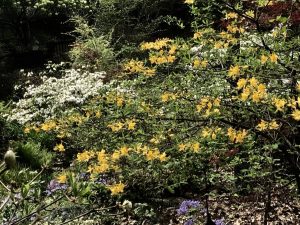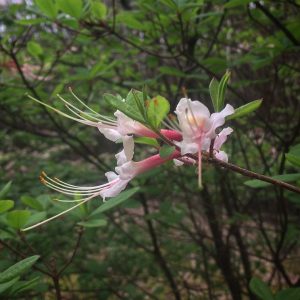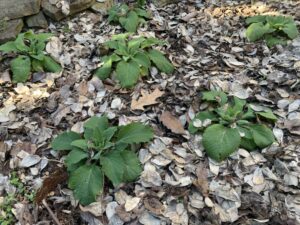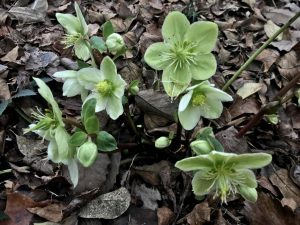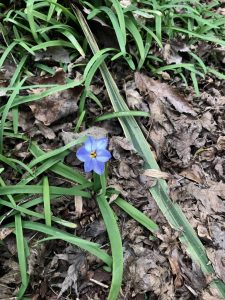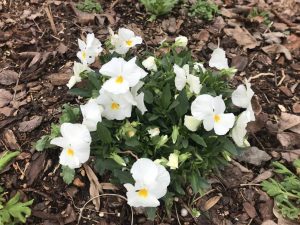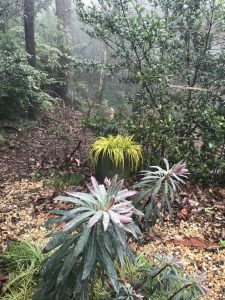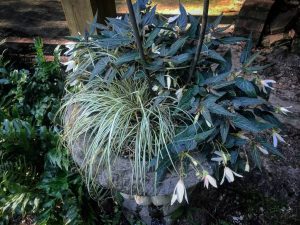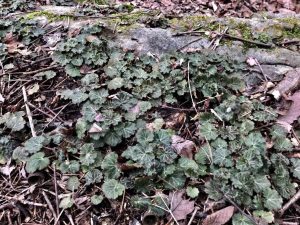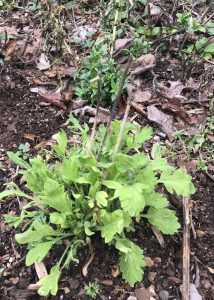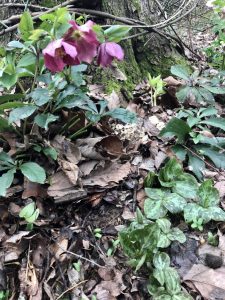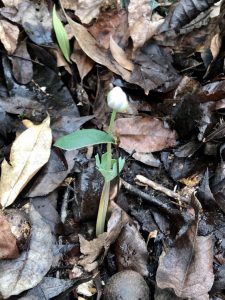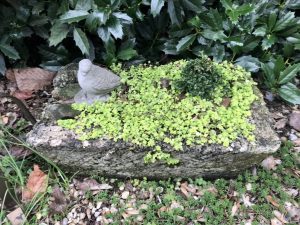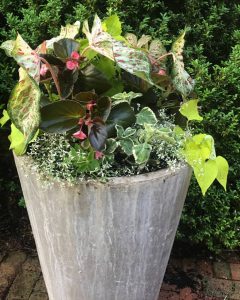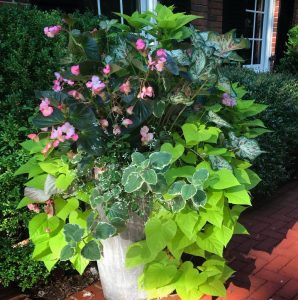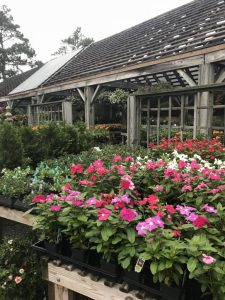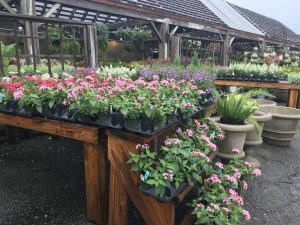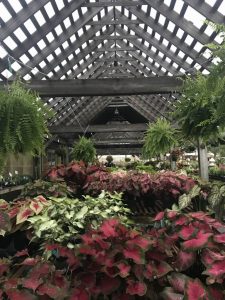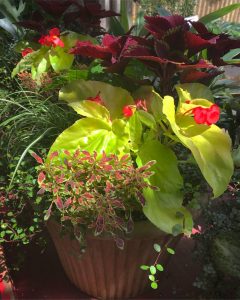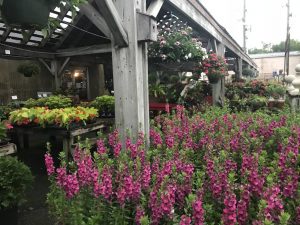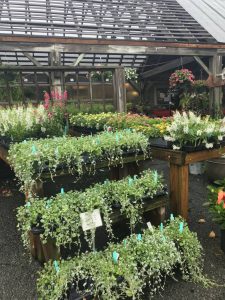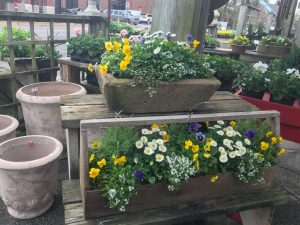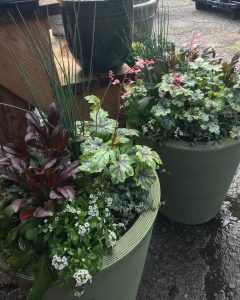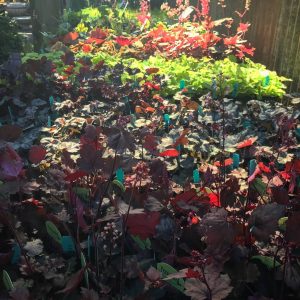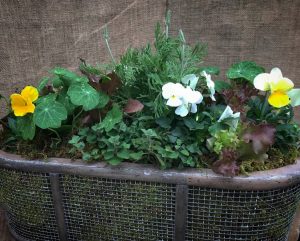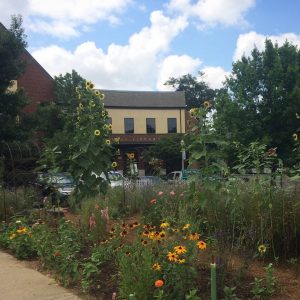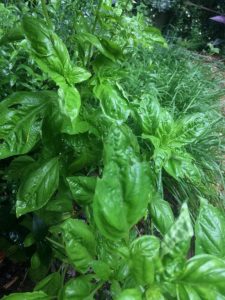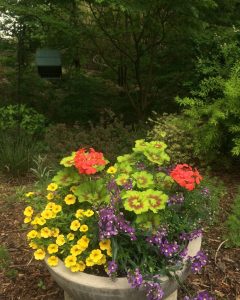Category Archives: Gardening Tips
Cosmos & Marigolds: Go-To Fall Blooms
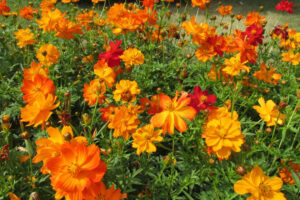
Cosmo flowers in a field
Ready to give your garden a fall facelift? Well, you’re in luck. The crew and I recently did a video on these fall beauties – they are not only super easy to care of, but are absolute CHAMPS in pots and garden beds alike. Here’s a little more information and a few tips to jazz up your garden this season.
Cosmos: Bringing Mexico’s Magic Right to Your Backyard
Okay, so let’s talk cosmos. These beauties are native to the meadows and scrubs of Mexico, but they’re now flaunting their vibrant colors all over South and Central America. The colors range from sunny yellows and oranges to dreamy pinks, whites, and even a deep maroon – they’ve got it all.
Po-tip? Get them some good sunshine and make sure the soil drains well. And DO NOT FORGET to snip off those old blooms. It keeps them looking fresh and encourages more of those lovely petals to pop up. I know it’s a little bit of work, but trust me; you’ll thank me later.
Marigolds: The Jack of All Trades in the Garden
And then, it’s over to the marigolds. These little sunbursts come in all sorts of shades – we’re talking orange, red, gold, and even white. And they really do light up just about any space they’re in. Whether in pots or planted in the ground, they aren’t fussy, just make sure they don’t sit in waterlogged soil.
DO deadhead your marigolds, like with cosmos. When you remove spent blooms, the plant will produce more buds, and boom – more color.
If you don’t want to deadhead your marigolds, it’s fine – it doesn’t necessarily hurt anything, but I don’t believe you’re getting as much out of the plant that you could. Up to you. (But I tell everyone to do it, so there you go.)
CHECK OUT OUR VIDEO ON COSMOS & MARIGOLDS!
All About Cosmos and Marigolds This Fall
As summer waves goodbye and fall starts to roll in, we can’t help but fall head over heels for the warmth and color that cosmos and marigolds bring to the garden. Whether you are newbie gardener or a seasoned pro, marigolds and cosmos won’t let you down. Cheers to a colorful fall! ![]()
![]()
– Kris
Staying Safe in the Garden: Beat the Heat

Hot Weather Clip Art drawing (Vector cliparts) clipart,hot,weather,sun
So, with the sun cranking up the heat and heat advisories doing their rounds in the Southeast, I wanted to talk about keeping safe while working outdoors.
Many dermatologists insist on proper sun protection. The sun’s ultraviolet (UV) rays can cause lasting damage to your skin, ranging from sunburn to more serious conditions. Sunscreen is your best friend here. I make it a habit to apply sunscreen generously and frequently, even if I’m working in the shade.
Let’s talk clothes, folks. Light long-sleeved shirts, those cool wide-brimmed hats, and sassy sunglasses – they’re not just for looking cute. I like to pair a breathable long sleeve shirt with light pants and a wide-brimmed hat to keep my sun exposure minimal and protect my skin while keeping cool.
Also, know that it is super easy to get dehydrated fast while in your garden. The sun, the heat, and physical activity can and will drain you fast. I keep a water bottle nearby all the time. And let’s be honest, who doesn’t love those refreshing breaks to sip and soak in the garden view?
By the way, if you’re more of a visual learner like me, I’ve got a cool video to share. Check out my insights on staying safe in the garden!
Remember, staying cool in the garden isn’t just about the plants – it’s about you too. And trust me, that balance between creating a gorgeous garden and looking out for yourself? It’s the real craft sometimes. So get out there and savor your green haven while staying sun-smart.
– Kris
Fall Planting Tips To Creating A Great Spring Garden
Fall Planting Tips To Create A Great Spring Garden:
-
Amend your soil. You might think since you followed our advice and added soil conditioner, PlantTone, or compost to your beds last spring you’re done. Not so fast! High temperatures break down soil amendments quickly, and plants take up nutrients. Continue adding to your soil every season. Healthy, loose soils create healthy plants. (Instead of putting fallen leaves to the curb, start a compost pile with them, or run over them with your lawn mower and throw them in your beds. They’ll decompose and add to your soil’s structure and health.)
- After you get your plants home, be sure to keep them watered, especially if you can’t plant them right away. We water small transplants in 4″ pots and cell packs at least once a day, especially if it’s hot and sunny. Of course, less water is required in cloudy, cool conditions. Right before you plant them, be sure they’re moist.
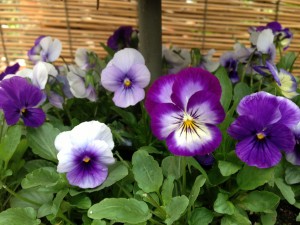
- Early in the season while the soil is still warm, you can still plant with Osmocote. However, later in the winter months, use Calcium Nitrate to feed your plants, especially if the foliage of your pansies turns a reddish color. Remember, you’re planting for spring color, though on warm days through the winter you should also have some blooms.
- Water your bed thoroughly after planting, and keep it watered while your transplants are getting their feet settled in their new home. Take care not to overwater, though, especially as the temperatures cool down going into the winter months.
- Mulch your beds with shredded mulch or pine straw to keep soil temperature around the roots as warm as possible.
- Deadhead your pansies and violas! I can’t stress enough how important this is. A pansy that you leave a dead bloom on will form a seed there, instead of putting that energy into more flowers. Make a practice to walk through your garden at least once a week, taking a good look at your plants and deadheading faded blooms. If you’ve missed some, you’ll see the seed pod beginning to form. Pinch any and all off! This will go a long way toward keeping your pansies happy!
Have you seen any of the videos we’ve been posting on our FB and Instagram? If you follow us, maybe you have! If you’re not on social media though, you can also find us on our YouTube Channel. Yes, we have a YouTube channel! Just search for Oak Street Garden Shop, and subscribe if you’d like to see more!
By Kris Blevons
– Posted using BlogPress from my iPhone
Don’t Stress If A Plant Is An Ugly Duckling – Imperfection Can Be Beautiful Too!
 I have a tiny oak tree out back that used to be on its way to attaining an impressive size – until Hurricane Ivan hit and toppled a huge hickory tree onto it, effectively topping it.
I have a tiny oak tree out back that used to be on its way to attaining an impressive size – until Hurricane Ivan hit and toppled a huge hickory tree onto it, effectively topping it.
I know I should have taken it down when the tree company came to clear out the downed hickory, but I couldn’t do it. I liked that little oak, and over time it’s become my crazy tiny oak tree up in my rock outcrop – a hurricane survivor.
I was working up around that oak this morning, cutting a few dead branches out of it and wondering at its tenacity. Below it, also improbably growing in the rock outcrop, is a shrub called Thujopsis dolobrata – a prized specimen I planted years ago.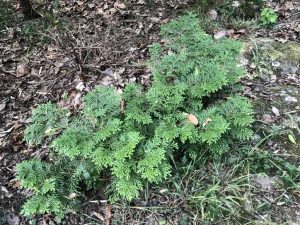
Unfortunately the Thujopsis started dying one summer, a victim to the previous fall’s drought. I watched anxiously as branch after branch eventually turned brown and died.
Unbelievably, about a third rallied and is still alive. I cut out the dead and now have half a shrub under my dwarfed oak tree. What a pair of misfits in the garden!
My imperfect garden might not be to everyone’s taste; but I’d rather have a little imperfection than everything being “just so”. A friend in the horticulture profession said it well:
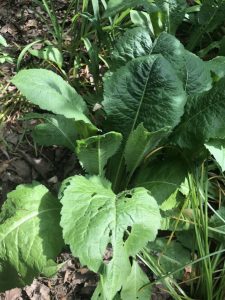 “Plants are living things like humans. They need water and sun and some need food and each grow in different ways. That yellow leaf at the bottom of the dracaena doesn’t mean that there is something wrong or that the plant is dying – it’s just a natural part of the life cycle. People need to understand that imperfect is beautiful.”
“Plants are living things like humans. They need water and sun and some need food and each grow in different ways. That yellow leaf at the bottom of the dracaena doesn’t mean that there is something wrong or that the plant is dying – it’s just a natural part of the life cycle. People need to understand that imperfect is beautiful.”
My physically imperfect tree and shrub were caused by events out of my control – a hurricane and a drought. Other imperfections are simply part of a plant’s life cycle, yellowing leaves, and damage caused by insects or animals.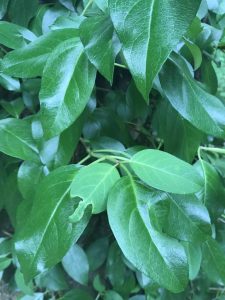
While it’s important to maintain a healthy landscape, it’s also important to know when to relax and appreciate that some imperfection is normal and not always cause for immediate alarm.
With proper watering, fertilizing, pruning and general maintenance, your plants will be better prepared to weather anything nature throws at them – and you will too.
By Kris Blevons
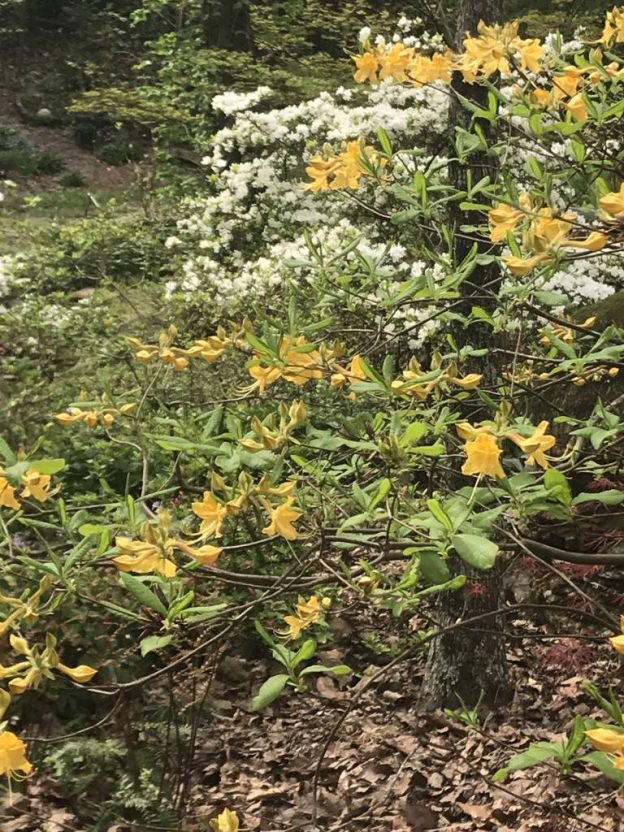
Native Azaleas and Hybrid Aromi Deciduous Azaleas Add Blooms, Scent, and Structure to the Garden
March and April are the months in the south that finally drive winter out for good, after the usual roller coaster rides with temperatures rising then falling, and multiple cycles of freezing and thawing.
Though our last average frost isn’t until mid-April, this year the fat buds of cherry trees and crabapples, spiraea, forsythia, and many more have burst into fragrant, beautiful bloom, and neighborhoods are awash in color.
Favorite shrubs of mine that add to the spring symphony are our native deciduous azaleas and the hybrids that have come along in recent years.
We have a selection available now, and, as they’re considered by many to be some of our most beautiful flowering shrubs, you might like to add one or more to your garden this year.
Large, fragrant, honeysuckle like blooms open gradually, offering nectar to swallowtail butterflies and hummingbird moths. It’s a delight to catch these pollinators “working” the blossoms!
A mistake many people make when deciding where to put their deciduous azalea is placing it in too much shade.
They do need some sun to bloom well, so be sure to think about how much shade mature trees cast in your landscape when considering your placement.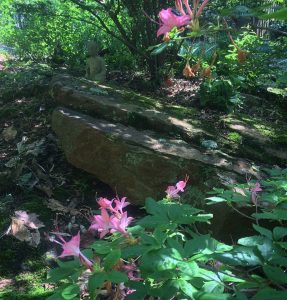
Once you’ve decided on your spot, don’t make the next mistake many people do when planting a new shrub, especially deciduous azaleas which are shallow rooted, by planting too deeply. Plant the rootball slightly high, water well, and mulch with pinestraw.
Once your shrub is planted, don’t neglect water. Though they need a well draining soil, they also need even moisture, so be mindful of this especially through the first two summers and possible dry spells.
Though they can grow up to 12’ in height, I do very minimal pruning on my deciduous azaleas, because they’re in a rocky area and haven’t quite gotten that big.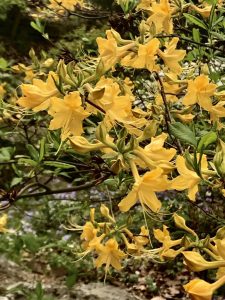
If you wish to prune yours, it’s best to prune early blooming varieties right after they bloom, since the following year’s flower buds form in June. With judicious pruning you can achieve a smaller shrub at around 6’.
Do you think you have just the right spot for at least one of these beauties? I hope you do. You’ll be creating your own magnificent symphony of color and scent for neighbors, pollinators, (and you!) to appreciate and enjoy.
By Kris Blevons
Cool Season Annuals…What Are They, And When Do You Plant Them?
The Birmingham area can see great fluctuations in temperatures in any given year, from sizzling summer highs in the upper 90’s to lows well below freezing in the winter complete with rain, sleet and even snow (Look HERE for a post on the blizzard of ‘93.).
For gardeners this can present a quandary when trying to decide among the dizzying array of plants at the local garden center. While the last average frost date here is mid-April, the soil can still be too cold for the real heat loving plants like zinnias, impatiens, lantana, and caladiums, to name just a few, that will sail through our blistering summers but languish in cold soil.
Enter the cool season annuals. These are the plants that prefer cooler temperatures and thrive in the early fall, winter, and early spring. If you know which ones they are and when to plant them, you’ll be ahead of the gardening game.
A few days ago, after we experienced temperatures in the teens at night with snow and cold weather for a number of days, I checked on some of my winter grown cool season plants to see how they’d fared.
The pansies, poppies, snapdragons, and foxgloves are very hardy plants that I’d added to the garden in October and November, though if you find larger transplants they can be planted in late winter as well. They looked fine, though some that were more exposed had damage. As temperatures warm they should rebound nicely.
But, since they’re also considered cool season annuals, they’ll fade as our spring heat arrives for good in May. Then it will be time to replace them with the real heat lovers I mentioned earlier. Remember, our last average frost is right around mid-April. We can count on things warming up quickly after this date. This is also about when everything in sight is turning yellow from the pollen falling everywhere – including covering cool season plantings and our cars!
Cool season annuals have a tough life. They might like it cool, but freezing is a bit much even for them. The picture of the poppy here shows what happened to the majority of them that were just beginning to put up fat buds when temperatures dipped into the teens for a few nights in a row.
The buds were completely frozen, but the plant itself came through fine since since mulch helped keep the plant and rootball warm. They too will be in full bloom in another month or so and are examples of what can be planted from 4″ pots in the fall.
The second picture shows (circled) seedlings of larkspur and poppies grown from seed sown directly into the garden in December. I sow extras any time from November to January when the soil is cold enough for their liking.
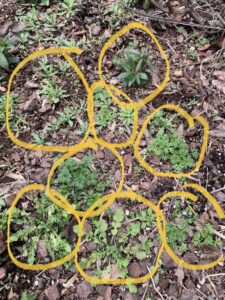 At any rate, you can see these tiny plants in this sunny, south facing bed weren’t fazed by the cold temperatures at all. I’m looking forward to their blooms in the late spring!
At any rate, you can see these tiny plants in this sunny, south facing bed weren’t fazed by the cold temperatures at all. I’m looking forward to their blooms in the late spring!
Some other cool season annuals that are more frost tender will begin to arrive in the garden shop soon. They include sweet alyssum, geraniums, petunias, nasturtiums, bacopa, and more. Because they come out of cushy greenhouse environments you’ll want to protect them from any late freezes.
We’ll check back on these plantings in future posts.
If you follow us on Instagram or Facebook you’ve probably seen a new series of shop videos – if not, follow us and check them out! They’re also on our YouTube channel under Oak Street Garden Shop – if you’d like to see more, subscribe!
By Kris Blevons
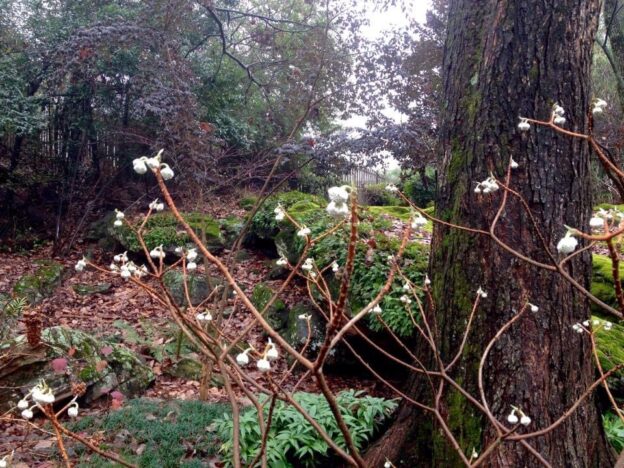
Edgeworthia chrysantha…A Great Shrub To Grow
I can’t imagine why, after all these years, this is the first I’m writing about one of my favorite shrubs, Edgeworthia chrysantha, or paperbush.
 This wonderful plant for our area has interest in all the seasons, culminating with fragrant blooms in spring.
This wonderful plant for our area has interest in all the seasons, culminating with fragrant blooms in spring.
Its open, well branched growth habit and winter silhouette in the garden is superb, as buds that form in the fall add interest and promise through the long winter months.
After the bloom period is over, the leaves begin to emerge with silky, white hairs, with a lovely, bluish color and slight silver tint.
The scent is what will knock you out though. It’s slightly spicy and is one of those fragrances that you’ll get a hint of before you see the plant. Believe me, everyone will ask what it is and where you got it the first time they come across it.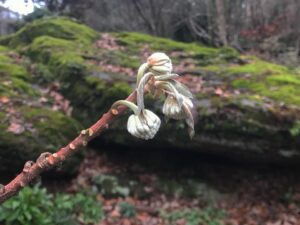
Edgeworthia is native to woodlands in the Himalayas and China. The inner bark can be used to make paper, hence the name paperbush. Edgeworthia is grown in Japan expressly for making paper out of the inner bark…for bank notes.
Part shade is the best place to grow your edgeworthia. They appreciate rich soil, never too dry. If you try to grow it in too much sun the color won’t be quite as pretty. Speaking of color, in the fall the leaves turn shades of yellow. Yes, it really does give all season interest!
 Provide it some room wherever you decide to plant it. Its width at maturity will be at least 7 feet wide and as high.
Provide it some room wherever you decide to plant it. Its width at maturity will be at least 7 feet wide and as high.
Mine is very wide but not at 7 feet tall yet. Here you can see it, to the left of the tree in my garden. It seems to be continuing to spread, and has suckered a bit, obviously wanting to take up some more real estate. I think I’ll let it!
If you follow us on Instagram or Facebook you’ve probably seen a new series of shop videos – if not, follow us and check them out! They’re also on our YouTube channel under Oak Street Garden Shop – if you’d like to see more, subscribe!
By Kris Blevons
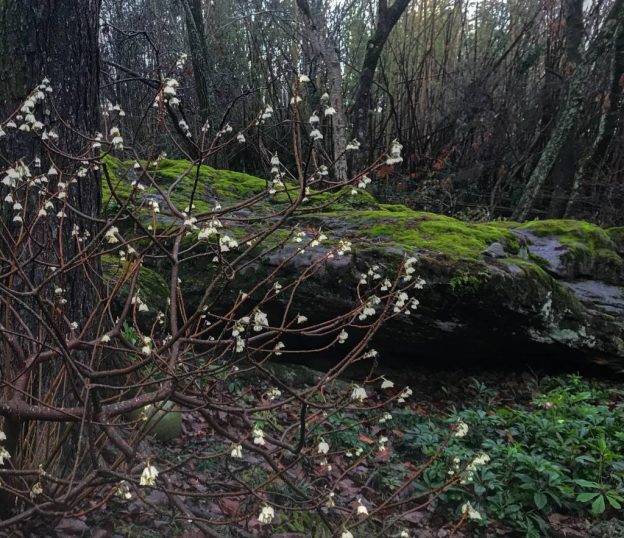
The February Garden, Dreaming Of Spring
Recently on a weekend off I spent a bit of an afternoon doing some necessary chores in the garden and much of the rest simply piddling.
I enjoy observing my plantings, checking buds on shrubs and trees, and scratching through the leaf litter looking for signs of life from perennials I know are there but just not awake yet.
I call these tours of the garden ‘taking a walk.’ When I say that, my husband knows I’ll be gone a while, and, if it’s in the afternoon, he usually has a glass of wine ready for me, knowing I’m not planning on doing any serious work.
Earlier in the day I’d cut back the Carex ‘Blue Zinger’ that is slowly beginning to take over the corners of some raised beds where I’d planted it a few years ago.
The Carex family is a tough group of plants, and this one has a beautiful blue hue that I admire. A couple of other carex in my garden include ‘Evergold’, a cream and green variegated selection, and ‘Everillo’, a chartreuse beauty that lights up any shade area its placed in.
The larger areas of mondo grass will be tackled soon, as February is the month to get all the ornamental grasses cut back to make way for fresh new growth.
Some plants hug the ground tightly, as if hanging on for dear life. The strawberry begonias are like that. I know in another month or so though that their delicate white flowers will be reaching for the sky.
This winter saw a few cold snaps, but even so, with this string of very wet days and warmer temperatures, the pansies will hopefully begin to look happier, not hunkered down and miserable but plump and full of buds and blooms.
I deadhead the ones that need it and notice the poppies I’d planted last fall are taking on their characteristic spring fullness as well.
The snapdragons have green growth beginning to show below the brown tops, and there are larkspur seedlings coming up between them too. Sometimes it’s a waiting game, requiring patience to see what will be.
The tiny ipheion are beginning to bloom, the earliest of my bulbs, their flowering always coinciding with the first of the veronicas, ‘Georgia Blue’. I make a note to combine these two for an early symphony of blue next year.
Of course the Lenten roses are blooming, stalwarts of the shade garden, and I diligently pull seedlings that come up each year too close to a patch of prized trillium.
This year I’ve added some hybrid Lenten roses in beautiful hues with blooms held proudly – they’ll stay in one spot rather than seeding themselves and cavorting through the garden like the others.
I turn away and spot the very first bloodroot bloom and immediately go to check another area I know they’ll be, but there’s no sign of them. Microclimates at work!
Golden leaved Sedum makinoi ‘Ogon’ is filling a small trough planter and looks none the worse for the winter. It’s also in other containers and in the ground as well.
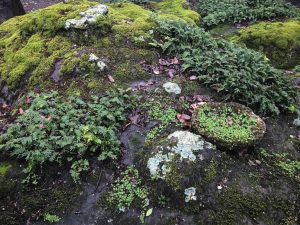 Sedum makinoi grows at the very top of the rock outcrop, happily mingling with resurrection fern. I clamber up the rocks, to check it out.
Sedum makinoi grows at the very top of the rock outcrop, happily mingling with resurrection fern. I clamber up the rocks, to check it out.
I continue on with my walk and notice the ipheion isn’t blooming quite yet at the base of a bird bath.
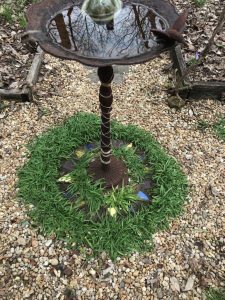 Native azalea buds are full of promise. I love their honeysuckle-like fragrant blooms and can almost smell them, but no, that’s the edgeworthia. It and the daphne are at their best now and perfume the air. Next month will be the native azalea’s time.
Native azalea buds are full of promise. I love their honeysuckle-like fragrant blooms and can almost smell them, but no, that’s the edgeworthia. It and the daphne are at their best now and perfume the air. Next month will be the native azalea’s time.
I make my way back to the house, past the Spiraea ‘Ogon’, in full bloom with it’s tiny white flowers. I know that froth of white will soon give way to chartreuse, airy foliage, yet another promise of spring on a gray, February day.
By Kris Blevons
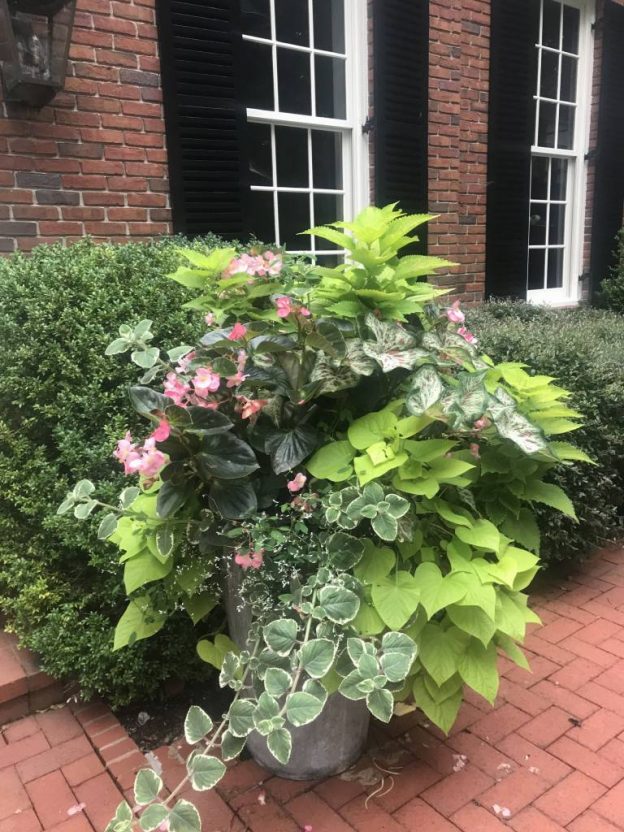
The Gardening Tool That Is Always With You
Do you forget each year exactly what you planted the year before or have trouble keeping track of how many plants you used in a planter or bed?
There’s an easy answer, and it’s probably in your pocket or purse right now. Our phone cameras are a great gardening tool.
I use mine to take pictures of new container plantings and garden beds and continue taking pictures through the season to track the progress of their growth.
The pictures here are one example. These planters are on a busy street and are seen from some distance, so they need to grow large. I took pictures the day they were planted and a couple of times after to show the progression of their growth.
Taking pictures as a reference is helpful if you’re asking for help choosing plants for your garden too. Simply take your pictures into the garden shop the next year and let them see what you did the year previous. Then you can recreate all or part of it – or none of it if it didn’t do well for you. It’s really a very helpful tool!
These containers are tall and narrow, and they’re planted intensively, so consistent watering is a must. The first pictures were taken at the beginning of May and the final shots are at the very end of July.
After 3 full months they’re still looking great, and with some clipping to cut back the coleus they should continue well into September.
This is also an example of choosing the right plants for the person. She’s a busy mom who doesn’t want to fuss over the pots and is lucky enough to have her mom help water when she’s out of town.
I chose the lime green coleus and big leaf begonias because I knew they’d grow large and accented them with the variegated leaves of cuban oregano and caladiums, then tucked in the airy white blooming euphorbia. The potato vine is another toughie that contributed more of the chartreuse green color to show up from a distance.
If you have a difficult time keeping track of names of plants, using the Notes feature of your I-Phone can help. As a matter of fact, I have an entire list of most of the plants in my garden in my phone. Believe me, I’ve always depended on pen and paper jotting down info here and there, but more times than not I misplaced them. Now I keep notes on my phone and they don’t get lost!
By Kris Blevons

Snapshots of the Nursery In June…It’s Not Too Late For Flowers!
One cloudy morning right before a deluge of rain, the light was finally right to take a few pictures of the nursery. Usually the light is too bright, or we’re busy unloading trucks, helping customers, filling orders, and generally running around.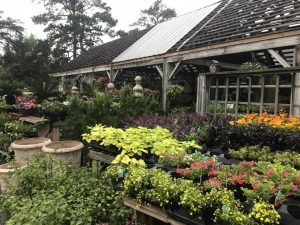
I’m certain the shots here would be better with a great camera (These are IPhone pictures.), but this gives you an idea of the amount of material still available, fresh plants from local growers ready to take on the midsummer heat.
Some of the best annuals for summer planting and filling in tough spots are vinca. They come in a range of colors and once established are extremely drought tolerant. Trailing varieties are also available.
Upright pentas are another workhorse of the summer and are butterfly favorites too. This is another that hybridizers have improved upon each year, and one that also has a trailing version, perfect for sunny containers.
We still have a selection of caladiums too, and the majority of them will tolerate sun as well as brighten shady spots in the garden. If you’ve ever looked at your garden beds and seen nothing but little leaves and a few blooms, caladiums might be just the thing to add that interesting and colorful foliage element to your design.
This year there’s a new begonia called ‘Canary Wing’ that’s been fun to play with in mixed containers, but it would also be stunning as a single specimen in a pot or massed in a shady garden bed. The red blooms on this large begonia contrast beautifully with the bright yellow leaves.
As you walk through the nursery, you’ll see a myriad of other choices including angelonia, a great bedding plant for sun. It’s best used in masses, and the spiky blooms add visual contrast when used with other blooming plants like lantana and vinca in sunny spots.
Silver dichondra adds its silvery sheen to plantings, cascading down the side of pots, over walls and between plantings. It’s a tough plant and drought tolerant too.
So, if you simply need a few fill-in flowers or have a larger area that still needs planting, we have plenty of healthy and beautiful choices for your garden. And, while you’re here, take a browse through the perennials and herbs and stroll through the greenhouse as well!
Ideas For Container Gardens In The Sun
Even in June we have folks come in to get planting advice for their garden beds and pots. It’s never too late to plant something! Here are a few ideas for your summer planters.
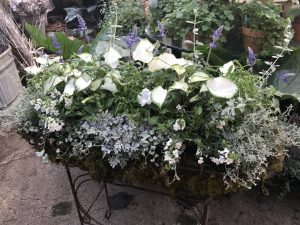
Keep in mind you don’t have to make fancy plant combinations if you feel unsure of yourself. You can also choose to use just one kind of plant in a planter.
The bottom line? Do whatever you feel works for you and your landscape. The staff at Oak Street Garden Shop and I enjoy putting together combinations of plants though, so here are a few examples of that type of planting.
The wire plant stand shown in the first two pictures lives at a local restaurant, receives lot of sun, and is well tended. It was first lined with a thick layer of green sheet moss, then soil and Osmocote were added (We mix in this slow release fertilizer to all of our plantings.), and finally plants were positioned.
 Because this needs to show up in the evening as well as during the day, the color scheme is white and silver with a touch of blue. It’s sited in front of a window and needs to look good all around as patrons also view it from inside the restaurant.
Because this needs to show up in the evening as well as during the day, the color scheme is white and silver with a touch of blue. It’s sited in front of a window and needs to look good all around as patrons also view it from inside the restaurant.
Blue salvia and silver germander will give height to this planting and spiky blooms, silver artemesia, sun tolerant caladiums, and an airy white euphorbia will add fullness, while a trailing artemesia, spreading angelonia, helichrysum, and silver dichondra will spill out the front.
The next example is simpler since the container, a bowl made out of hypertuffa, is smaller. Again, the plants chosen will work in the sun if care is taken to keep the contents watered. Our advice, unless it rains, is to water each morning, thoroughly in the heat of summer, and check the planting again each afternoon.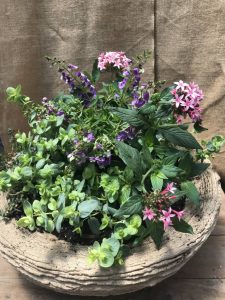
Three types of plants fill this bowl: spreading angelonia, ornamental oregano, and trailing pentas. Each of these will either spread out or trail, so the overall look will be of a mounding planting. Each of these has a different shape bloom, so there will be contrast in form as well as color of foliage or flower.
The final example is an intensively planted, heavy glazed container that a customer brought in to be planted for a wedding party. Her color scheme was white, pink, and purple, and some variegated and silver foliage was used as well.
 Because this needed to be intensively planted to look “grown out” immediately, maintenance will be important, and plants will need to be cut back periodically and groomed often. The planter sits against a wall in hot sun, so the view is 3/4 around.
Because this needed to be intensively planted to look “grown out” immediately, maintenance will be important, and plants will need to be cut back periodically and groomed often. The planter sits against a wall in hot sun, so the view is 3/4 around.
Here Iris pallida was the starting point, then silver artemesia, silver germander, upright and spreading angelonia, and trailing plants of both purple and white scaevola were added to complete the planting. Again, there’s contrast in foliage color, bloom form, and growth habit.
The mixed planting combinations shown here could just as easily work in a sunny garden bed too.
Experiment with new plants you might not be familiar with, try different combinations, whether they’re all in the same pot, one plant type in a container. or in the ground. You just might find a new favorite!
Plants used in these containers include:
Sun tolerant caladiums: There are many out there. The sun caladiums generally have lance shaped leaves. Blue salvia: Again, look for salvias that grow between 12″ and 18″ the size best for most mid-size container gardens. Euphorbia: There are many, and they all offer an airy growth habit with small white blooms. You can’t go wrong with any of them! Helichrysum ‘Silver Star‘: This is an excellent choice for southern gardeners, usually available only early in the season. Doesn’t “melt out” like most other helichrysums do for us.
Silver dichondra: Don’t let it’s skimpy appearance in the pot fool you. This is one of the best choices to create a silvery waterfall of coin shaped leaves to trail out of containers in the sun, and it loves the heat too! Angelonia: Sometimes referred to as summer snapdragon because of it’s bloom shape. Angelonia comes in an upright form perfect for the center of containers or in garden beds and as a spreading plant, more lax and outward growing.
Artemesia: Good for a silver foliage element. ‘Powis Castle’ is big and billowy, ‘Silver Brocade’ spreads out and down. Silver germander: A lovely upright growing plant used for foliage texture and color. An excellent plant to add structure to plantings, though it can be difficult to find.
Pentas: A workhorse for us. They’re available in an upright form, useful for adding height in containers, and now there’s also a trailing variety. They do require deadheading to perform their best. Ornamental oregano: Another that can be difficult to find, but if you can, the trailing habit and pink bloom bracts make it a winner.
Scaevola: This spiller comes in a range of colors: white, pink, blue, or purple, so it can be used with any color scheme. Clip it back periodically to keep it from getting ragged. Its other name is fan flower because of the charming fan shaped blooms.
Iris pallida: A striking iris, with either yellow (‘Aurea’) or white (‘Variegata’) variegated leaves, it prefers sun and dryish soil. Lovely light purple blooms appear in early spring.
A few more good choices not used here include:
Coleus: With their colorful leaves they brighten shady areas, but there are also many sun tolerant varieties as well. Sunpatiens: Provide plenty of water if you place them in full sun. Begonias: There are many excellent varieties out there including ‘Dragonwing’, ‘Big Leaf’, and others. It’s not your Grandma’s begonia world any more! Calibrachoa: Also known as million bells, these diminutive petunia look-alikes spill from containers with every color imagineable. Purslane: Colorful blooms close in the late afternoon on succulent, drought tolerant plants. Lantana: An old workhorse, new varieties are more compact and extremely floriferous.
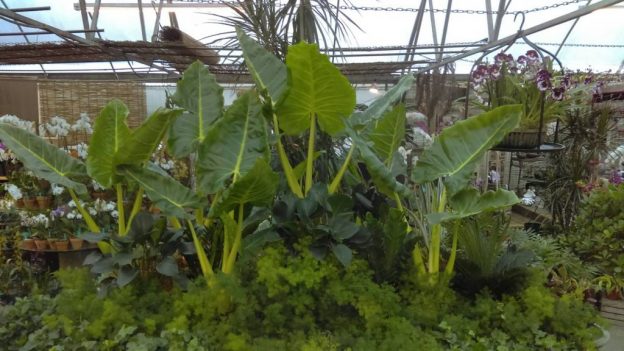
Alocasias, Tropical Beauties of the Summer
Bold and dramatic, the alocasias are one of the most elegant tropicals of the summer garden.
One look at the bright yellow stems of the showstopping giant Alocasia ‘Lutea’ rising at an angle upward can practically take your breath away. Mix it with darker green leaves and wispy foliage as a contrast and it’s unforgettable.
Alocasias are natives of Asia, from Sri Lanka and India through Southeast Asia to Indonesia. Keeping this in mind, Birmingham’s hot summer months are perfect for these giants from half a world away.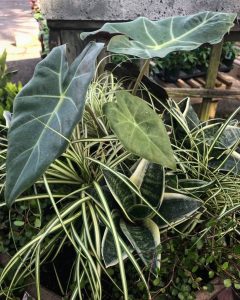
 If I had to give a favorite cultivar of Alocasia, it would be a tossup between the darker veined cultivars like ‘Mayan Mask’ and the above mentioned ‘Lutea’. But any of them offer a dramatic and large leaf presence in the summer garden.
If I had to give a favorite cultivar of Alocasia, it would be a tossup between the darker veined cultivars like ‘Mayan Mask’ and the above mentioned ‘Lutea’. But any of them offer a dramatic and large leaf presence in the summer garden.
Offer them dappled sunlight (More sun is ok, but be very sure to keep them well watered.) and ample moisture for the best growth. As large a pot as is feasible for your space, or well amended rich soil, if you’re planting them in the ground, will keep them happiest through the hot summer months.
If you follow us on Instagram or Facebook you’ve probably seen a new series of shop videos – if not, follow us and check them out! They’re also on our YouTube channel under Oak Street Garden Shop – if you’d like to see more, subscribe!
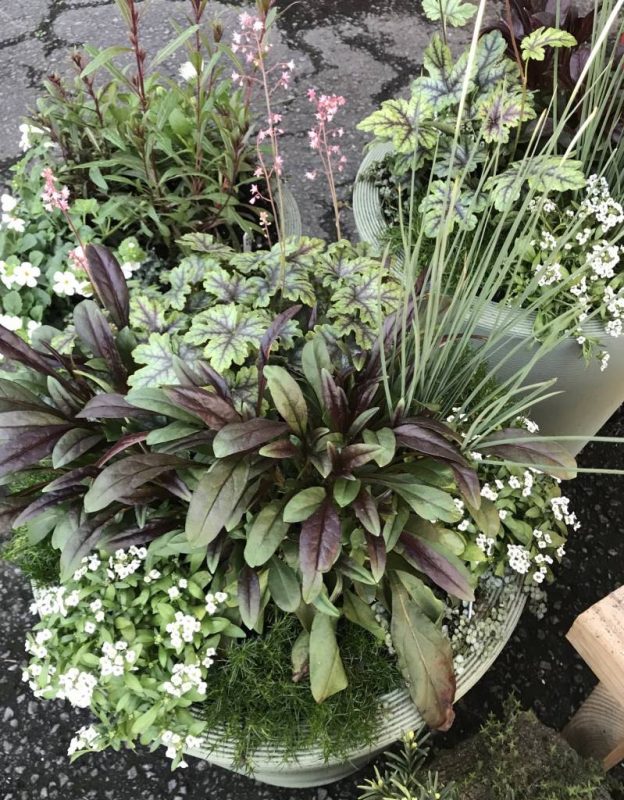
March…The In-Between Month
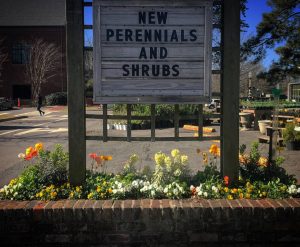 There’s really no in-between month for hard core gardeners, as there’s always something to do or a new revelation in the landscape.
There’s really no in-between month for hard core gardeners, as there’s always something to do or a new revelation in the landscape.
But for the more casual plant person, a few warm days signal it’s time to call or visit the garden shop to buy all the spring bedding plants they can get their hands on.
Unfortunately there are more than a few businesses willing to sell them, even knowing our last average frost in the Birmingham area isn’t until mid-April. But please understand, March soil is too cold for basil, tomatoes, begonias, caladiums, and more that are offered to tempt even the smartest of us.
This is why I call March the in-between month. It’s getting late to plant pansies and winter annuals, but it’s still early for the heat lovers, though we know their time is getting closer. Remember the blizzard of 93? That was 28 years ago – in March.
A better choice to spend money on now are perennials, those plants that return year after year. If you have planters small enough to cover easily or bring inside when temperatures drop, many herbs, cool season vegetables like lettuce, broccoli, and cabbage and some annuals (See list below.) that appreciate more moderate temps can be planted as well.
Some perennials available for early season purchase include Veronica ‘Georgia Blue’, creeping phlox, daisies, daylilys, many ferns, hellebores, stokesia, and lobelia to name just a few. If you don’t see something you’re looking for always ask!
Annuals and some herbs that do well in very early spring before our last average frost include thyme, chives, oregano, tarragon, lavender, sweet alyssum, bacopa, calibrachoa, geraniums, dianthus, marigolds, and diascia. Remember, you must protect newly planted greenhouse grown annuals from freezing temperatures.
By Kris Blevons
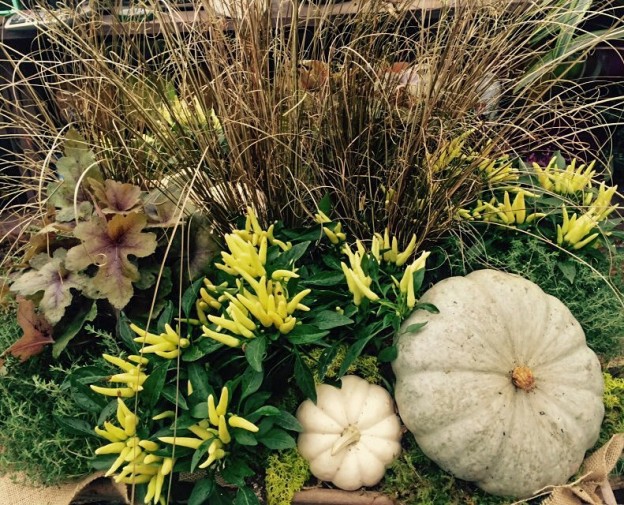
Mums…And More!!!!
Every year around August and September, when the heat of summer has wiped out once fresh spring plantings, almost daily we hear one of two questions from multiple people – “Do you have any mums?” and (insert desperate tone here) “When can I plant pansies??!??”
Well, as of this writing we do have plenty of mums, and, no, it’s not time to plant pansies – yet (October and November are the months, when temperatures begin to cool a bit.). But why settle for a simple mum now when growers are offering so much more this time of year? Here are a few interesting plants to use with the usual mums until its time for the winter fare of pansies, snapdragons, ornamental veggies, and more.
 A difficult plant to find but one that offers gorgeous fall color is hamelia. Enjoy it’s orange blossoms and beautiful foliage in a special container. Add some sweet alyssum and petunias to add even more interest. The planter shown here also has a small pot of asters that once finished blooming can be removed and planted in the garden.
A difficult plant to find but one that offers gorgeous fall color is hamelia. Enjoy it’s orange blossoms and beautiful foliage in a special container. Add some sweet alyssum and petunias to add even more interest. The planter shown here also has a small pot of asters that once finished blooming can be removed and planted in the garden.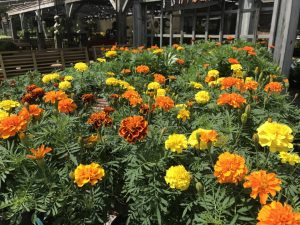
Marigolds are my unsung heroes of the autumn season. They bloom like crazy given some sunshine, prefer the cooler temperatures of fall, and offer loads of color. Who wouldn’t love that? I use them in the garden and tuck red or green lettuce and sweet alyssum in between for even more color. Try to use marigolds in planters or places you won’t be planting pansies though, because it can be difficult to make the decision to pull them out as they last even through a light frost.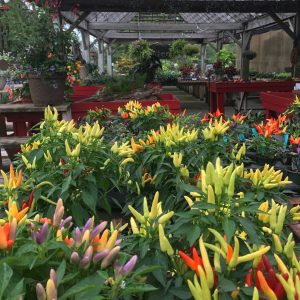
Another that has become a popular addition to the fall plant palette is the ornamental pepper. These small plants loaded with colorful fruit are an unexpected and fun way to usher in a new season. Add some cosmos too for added interest.
Don’t forget that foliage plants can add color as well. Heuchera offers colorful leaves for just about any combination, and the lowly ajuga can be beautiful too. Whatever you decide on, remember that there’s much more than mums for long lasting fall beauty; so venture out of the mum comfort zone and give them some companions this year!
By Kris Blevons
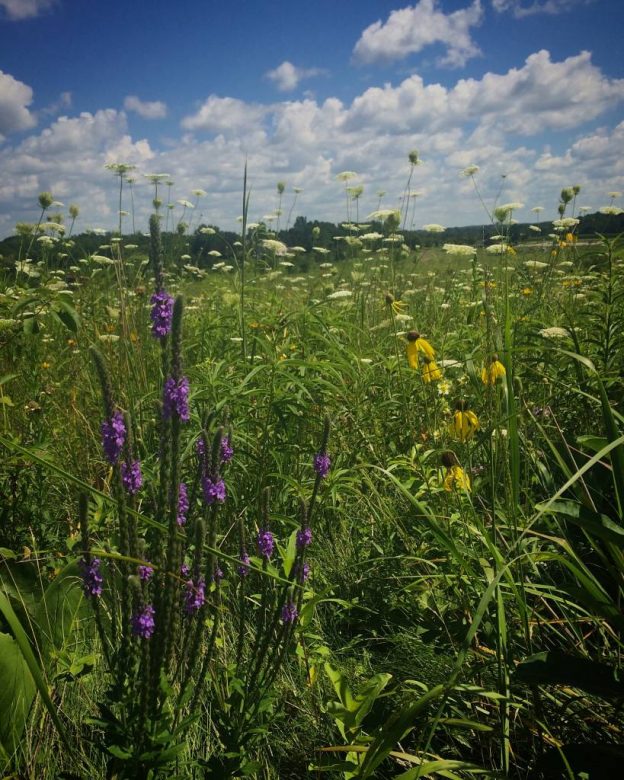
In Appreciation Of Pollinator Gardens…Large and Small
This summer’s “Better Late Than Never” pollinator garden is coming along and, as in years past, will get even more colorful as the end of summer approaches. I’m happy to see that private and public gardens and gardening for wildlife is a growing trend across the country.
I recently returned from a trip back to my home state of Wisconsin, where I visited a couple of county parks my late father helped make possible many years ago near the beginning of this movement in public gardening. My mother, sister, and I are certain he’d have been very pleased with the progress of this prairie reclamation in the middle of southern Wisconsin farm land.
 At Dorothy Carnes County Park & Rose Lake State Natural Area we watched as dozens and dozens of purple martins flew back and forth to houses set up for them, butterflies soared through prairie plantings, and a group of special needs children returned from a morning hike.
At Dorothy Carnes County Park & Rose Lake State Natural Area we watched as dozens and dozens of purple martins flew back and forth to houses set up for them, butterflies soared through prairie plantings, and a group of special needs children returned from a morning hike.
The next day we visited Korth County Park on Rock Lake and hiked down to a bench overlooking the water. Visitors can hike or bike along paths skirting the lake, and both parks have shelters used for picnicking. I feel so lucky to have visited these lovely and well maintained public spaces.
Our pollinator garden is tiny in comparison but there’s so much life in it too. This year I had trouble finding the peach porterweed that the butterflies adore, but a few weeks ago noticed that a number of them had reseeded from the previous summer’s garden. These volunteer surprises make this garden extra special.
Other “volunteers” this year are red gomphrena, rudbeckias with huge blooms, many zinnias, celosia, sunflowers, cosmos, hyacinth bean and moonflower vines on the arbor, cleome where the compost bin had been, and a lone dill plant. It’s truly an old fashioned cottage garden for the pollinators and the enjoyment of anyone who stops to look!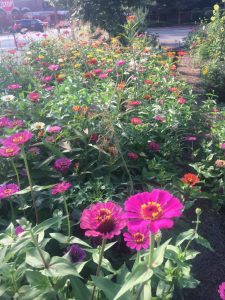
We also added a few new plants this year. Verbena ‘Lollipop’ and pentas for butterflies, cigar plant, pineapple and Mexican sage for hummingbirds, African blue basil and purslane for the honeybees, and red ruellia too.
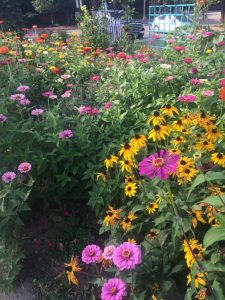 The Mexican sunflowers, tithonia, are also slowly getting larger and will add their bright orange blooms that the butterflies love as the summer wanes. The annual milkweed is in bloom now too.
The Mexican sunflowers, tithonia, are also slowly getting larger and will add their bright orange blooms that the butterflies love as the summer wanes. The annual milkweed is in bloom now too.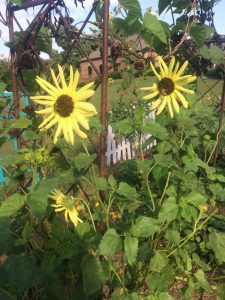
Perennials that return are always welcome in the garden! The butterfly weed, purple coneflower, and salvia greggii are old friends.
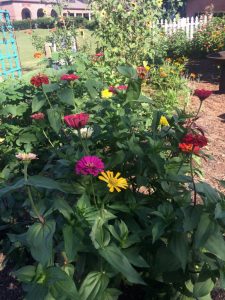 A woman approached me the other day as I was watering to say thank you and said she’s created a pollinator garden of her own after following the progress of this small space in the middle of Crestline Village.
A woman approached me the other day as I was watering to say thank you and said she’s created a pollinator garden of her own after following the progress of this small space in the middle of Crestline Village.
Talking with her and others has been so gratifying. I hope my Dad is watching from wherever he is and smiling at our efforts to create a beautiful space for community and nature too. If you’re in Crestline Village, I hope you’ll take time to stop and appreciate this little slice of pollinator heaven!
If you follow us on Instagram or Facebook you’ve probably seen a new series of shop videos – if not, follow us and check them out! They’re also on our YouTube channel under Oak Street Garden Shop – if you’d like to see more, subscribe!
By Kris Blevons
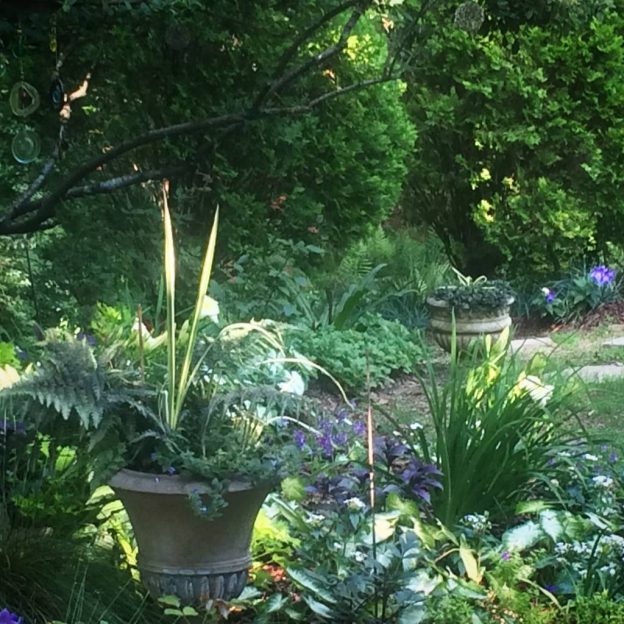
Leaving On Vacation? Don’t Forget The Garden…
 Today marks the summer solstice and the longest day of the gardening year, with the 4th of July holiday and our long southern summer ahead.
Today marks the summer solstice and the longest day of the gardening year, with the 4th of July holiday and our long southern summer ahead.
This can be a tough time for our landscapes as other activities – trips to the beach or mountains, weekend getaways, and more – lure us away from our ordinary routines.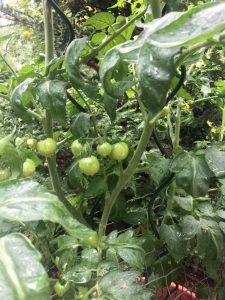
Before you leave for an extended time, make plans for a neighbor or friend to check on your garden. Ask them to harvest vegetables and herbs and keep any that they pick.
Basil in particular is a fast grower and benefits from being cut regularly. Give them an easy pesto recipe so they can make some for themselves (or even better, make some for them when you return).
Are there spots that need more water than others if it turns sunny and hot? Walk them through your landscape and give them a heads-up on problem areas or plants that you’d appreciate particular attention paid to.
If you have pots that will need consistent watering, group them together within easy reach of your hose. Remember very small pots dry out quickly, especially in windy conditions. Consider moving those in sun into more shade while you’re gone.
Walk your landscape and do any weeding, deadheading and cutting back, keeping in mind how much they will grow while you’re away. Make sure your garden beds are mulched and add some to the top of container gardens as well.
Finally, be grateful your friend made the time to check on your plantings but don’t expect perfection. If, when you return, there are overgrown plants, some that received too much or too little water, or vegetables that didn’t get harvested, don’t sweat it. After all, you just returned from vacation while they were hard at work for you!
By Kris Blevons

